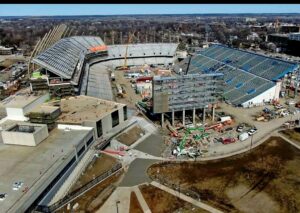For the Sake of Transparency: Revealing the “Other Side” of the New Booth Stadium – A $600 Million Renovation Anchored in Memory
As the ambitious $600 million renovation of Booth Stadium moves forward, excitement and curiosity are growing around the project’s many features: high-tech seating, expanded capacity, energy-efficient systems, and multipurpose university facilities. But amid the celebration of progress, many alumni, fans, and local residents have asked a quieter, more emotional question: What will happen to the “Other Side”?
Today, in the spirit of transparency and community respect, project leaders have chosen to reveal the plans for what many consider the heart and soul of the original Booth Stadium—a modest, worn but beloved section often referred to simply as the “Other Side.” While the main focus of the renovation has been on sleek upgrades and future-facing functionality, this particular space is being treated with a reverence that matches its sentimental value.

A Space That Held More Than Seats
For decades, the Other Side was more than a set of bleachers. It was where generations of students stood together through bitterly cold homecoming games, where alumni gathered to relive stories of youth, and where families brought their children to witness the tradition of university athletics.
It wasn’t the side that made it to the televised shots. It lacked luxury suites or press boxes. But it was real, raw, and uniquely human. Whether fans were huddled under blankets or standing in solidarity during a game’s final moments, the Other Side symbolized community at its most authentic.
So when plans for a stadium overhaul were announced, the fate of this cherished section became a source of concern and speculation.
Preserving Memory, Redefining Space
Project architect Dana Gillum, speaking during a recent community open house, emphasized that the renovation does not mean erasure. “We are not replacing history—we’re preserving it with purpose. The Other Side is being reimagined as the ‘Memory Promenade,’ a dedicated section within the new stadium footprint that retains the original bleacher wood, the same seating pitch, and even the viewline that older fans remember.”
The Memory Promenade will not only feature preserved elements but also interactive storytelling walls, digital archives of legendary games, and recorded messages from longtime fans. A patch of the original field turf—meticulously preserved during demolition—will be placed under glass as a tactile artifact of the past.

Furthermore, bricks and plaques from the old structure will be used in walkways and decorative borders, connecting the new with the old at every turn.
A New Role in a Modern Facility
Functionally, the Memory Promenade will still serve fans during game days, with seating available for those who want to reconnect with the spirit of the past. It will also be open during non-game days as a reflective and educational space for campus tours, alumni events, and student storytelling projects.
In partnership with the university’s Department of History and the School of Media Studies, oral history sessions are already underway to capture voices and memories linked to the Other Side. These testimonies will form part of an evolving digital archive accessible via QR codes and the stadium’s mobile app.
A Balance of Heritage and Innovation

The $600 million renovation is not shy about embracing the future. The stadium will feature state-of-the-art athlete recovery rooms, solar-powered lighting grids, advanced audio-visual systems, and an expanded footprint to host soccer, lacrosse, and community events. But even as it leans into innovation, the core vision remains tied to community—past, present, and future.
University President Dr. Alyssa Brenner summed up the approach: “You can build a modern facility with cutting-edge features and still leave room for memory. This isn’t about nostalgia—it’s about honoring legacy as a living part of progress.”
Community Reactions
Reactions to the reveal have been overwhelmingly positive. Jacob Meyers, Class of ’86, said, “I was worried they’d flatten it and forget it. But what they’re doing with the Memory Promenade is thoughtful—it lets us bring our memories forward, not leave them behind.”
Younger students have also expressed appreciation, seeing the space not just as a tribute to the past but as an inspiration for the kind of traditions they hope to create.
A Future Rooted in Remembrance
The new Booth Stadium is scheduled for completion in the fall of 2026. As work continues, the Other Side will remain a guiding compass in the project’s emotional and cultural planning. In transforming the old into the new, the university is crafting not just a stadium—but a story. One that stretches across generations and welcomes all who have ever found meaning in a bleacher seat, a cold night, and a shared cheer.













